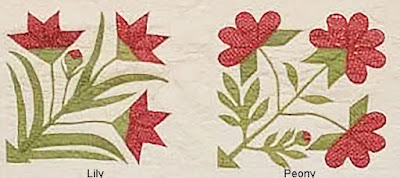A quilt recently up for auction.
With inscribed information on date, maker, place and what is most remarkable: Pattern names.
"The Peony & Lily
L. Maria Dunbar
West Hamilton
Madison Co
NY
May 1, 1851"
Two block patterns and a floral border with three or four designs.
The main floral with its 3 heart-shapes is an unusual design and I don't believe I've seen it before. We might call it a rose. But she called it a peony.
Which is the Peony and which the Lily?
Look at the leaves.
Maria captured the Paeonia lactiflora leaves accurately.
As I say we might think of these as roses. In my Encyclopedia of Applique you can find dozens and dozens of published patterns for "roses" and about a dozen named "peony."
Encyclopedia of Applique
Is that really a rose Marie Webster? Or is it a Piney?
Pronunciation and spelling of the word peony might be one reason we call them roses. We have so few examples of 19th-century quilts with the pattern name inscribed. But Maria Dunbar's makes three peonies.Shelburne Museum Collection
In 1847, Parnel R. Grumley Pierce (1820-1898) wrote " The Peony and Prairie Flower No 6 " on the back of her quilt.See more about Parnel here:
http://barbarabrackman.blogspot.com/2021/01/parnel-grumleys-peony-prairie-flower.html
New England Quilt Museum Collection
Binney Collection
"The Piony"
Note the leaves.
Parnel's peony
"Peony" from Ruth Finley's 1929 book
We also have published records of peony quilts as fair entries.
Mrs. A.A. Hosmer won a prize in New York in 1846 for
a "quilt (peony figure.)"
A fair in Troy, Kansas in 1872---Mrs Young's Peony losing out
to Mrs. Parker's California Wheel (we could digress into that name but NO!)
So this must be Maria Dunbar's Lily.
Mrs. Waters entered a "Lilly Pattern" in a Pennsylvania fair in 1851
A name that has endured.
One other name in Parnel Grumley's inscription: The Prairie Flower, a name that seems more a metaphor than botanic.


















.jpg)




That is interesting, the spelling of peony. My grandmother always called it a piony with the i as a short vowel sound!
ReplyDeleteIn Dutch we call the peony : pioenroos. The accent is on oe, pronounced as oo in cool. Roos as rose.
ReplyDeleteMaria's quilt is beautiful! I'd say that piony is a variant spelling of peony rather than a misspelling.
ReplyDeleteNann---you are right---not mispelled. That's not my caption. I wonder how many ways people spelled and pronounced the word and do today. I guess I could look it up in the Dictionary of Regional English. I say paan'ee.
DeleteThese are such beauties! Thanks for the history being them.
ReplyDelete